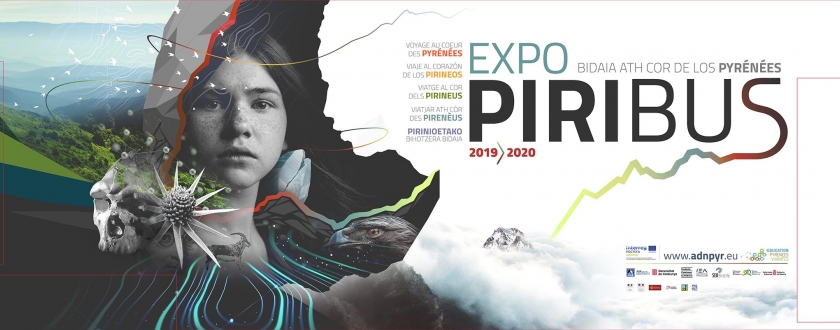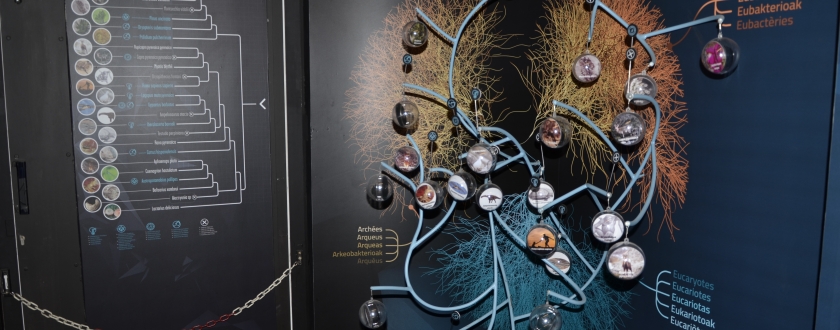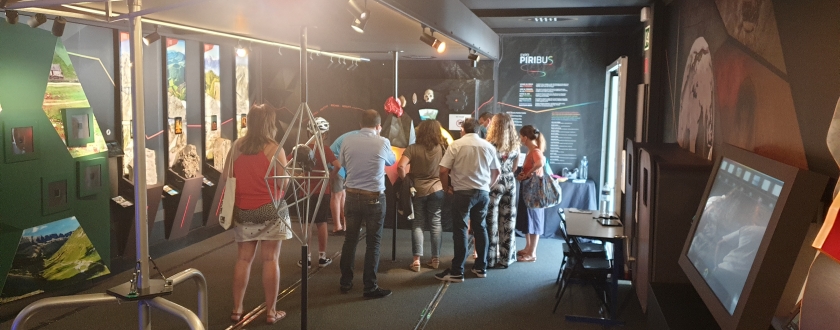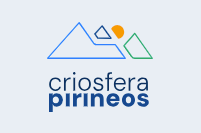PIRIBUS, A Journey to the Heart of the Pyrenees
Description of the case study
The travelling “PIRIBUS - A Journey to the Heart of the Pyrenees” exhibition is one of the actions of the ADNPYR Project’s “Pyrenees DNA, project to value Pyrenean heritage and Living Pyrenees Education Network cooperation”. This is an Interreg POCTEFA project that is financed by the European Union, 65% of which through FEDER funds, its partners being LPO, GENCAT, GAN, IEA-CENMA, SEO Birdlife, and FCLP, and led by the Living Pyrenees Education Network.
The aim of ADNPYR and PIRIBUS is to raise awareness and place value on mountain region identity through its heritage, in addition to stressing the importance of environmental education to face one of the 21st century’s greatest challenges: adaptation to climate change. This is done in a 72 m2 mobile exhibition space that holds a dozen devices, including 360º audiovisuals, touchscreens and sounds, samples and object handling, all of which aimed at speaking to visitors’ senses. Geological history, landscapes, biodiversity, and human history are four thematic spaces that allow the Pyrenees region’s heritage and identity to be explored. PRIBUS’s presence at the 32 planned stops is accompanied by parallel activities such as talks and documentary screenings, where the impacts of climate change on the Pyrenees region, its vulnerabilities, and adaptation, among others, are analysed and debated.
The entire mitigation and adaptation process for the effects of climate change must go hand in hand with public awareness-raising actions. Their involvement is necessary if the aim is to produce changes in behaviour that are in line with the new needs the climate emergency demands.
As it travels through the entire massif, PIRIBUS aims to present this diverse and unique reality of the Pyrenees region, with education certainly being one of the most effective ways of promoting changes to attitudes.
» Awareness-raising through a travelling exhibition.
» Valuing the Pyrenees region’s heritage through innovation.
» Establishing connections between environmental education and heritage valuation professionals.
» Promoting cross-border dynamics to obtain results that organisations would not be able to achieve on their own, and taking advantage of the experience of more than 65 entities that make up the Living Pyrenees Network, proposing strategic massif guidelines for the sustainable exploitation of Pyrenean assets.
On its journey through the Pyrenees region (not yet complete), the PIRIBUS has been able to reach a total of 42,694 individuals, 6,228 of them school-aged. As of now, a total of 330 environmental education and awareness-raising activities have been carried out complementing exhibition visits, with more than 266 environmental education entities having participated in its development and execution.
Case mainly implemented via objectives from other non-adaptation policies, though with significant consideration for climate change adaptation aspects.
REPV, LPO, GENCAT, GAN, IEA-CENMA, SEO Birdlife, FCLP.
Additional Information
The project is born out of the joint action of its partner entities: LPO, GENCAT, GAN-NIK, IEA-CENMA, SEO Birdlife, and FCLP. Its development and later leadership was carried out by the Living Pyrenees Education Network (REPV). In turn, the REPV is comprised of a total of more than 65 environmental education entities throughout the Pyrenees region, with participatory, cooperative, collaborative, and co-creation dynamics.
In terms of PIRIBUS’s leadership, open contracting processes have been launched for each of its stages, generally being led by one or more entities from each territory where the exhibition made its respective stop.
Success factors:
The Network’s cooperation has allowed for the development of a project of this magnitude. On a recipient level, another success factor is the warm welcome given to an exhibition of this kind in small and medium-sized municipalities where enjoying this kind of intervention is unusual.
Limiting factors:
» The difficulty of bringing the exhibition to certain municipalities.
» COVID-19 and pandemic restrictions, which have limited mobility and reduced public service capabilities.
In general, educational actions are difficult to pass through a cost-benefit filter, as the values an exhibition provides are intangible within the individual. However, the large number of visitors together with participation in activities and their level of satisfaction tip the scale in favour of the action’s benefit.
As previously mentioned, the Pyrenees DNA project is backed by financing from the INTERREG POCTEFA programme.
11/01/2017 - 12/31/2021 (4 years- in progress)
Reference information
PYRENEAN CLIMATE CHANGE OBSERVATORY
Avenida Nuestra Señora de la Victoria, 8
22.700 - Jaca
Huesca - España
+34 974 36 31 00
info_opcc@ctp.org







